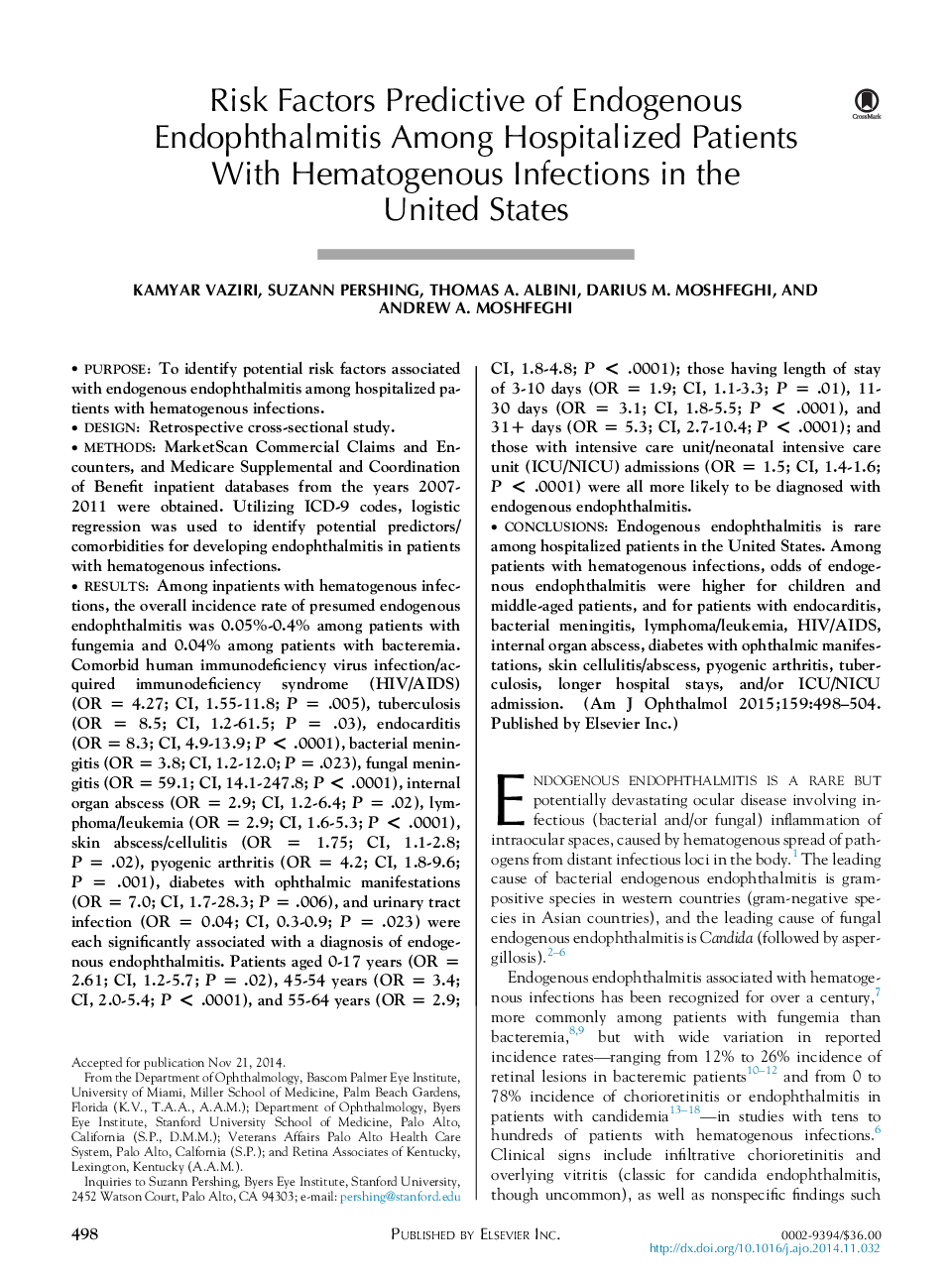| کد مقاله | کد نشریه | سال انتشار | مقاله انگلیسی | نسخه تمام متن |
|---|---|---|---|---|
| 6195204 | 1602126 | 2015 | 7 صفحه PDF | دانلود رایگان |
PurposeTo identify potential risk factors associated with endogenous endophthalmitis among hospitalized patients with hematogenous infections.DesignRetrospective cross-sectional study.MethodsMarketScan Commercial Claims and Encounters, and Medicare Supplemental and Coordination of Benefit inpatient databases from the years 2007-2011 were obtained. Utilizing ICD-9 codes, logistic regression was used to identify potential predictors/comorbidities for developing endophthalmitis in patients with hematogenous infections.ResultsAmong inpatients with hematogenous infections, the overall incidence rate of presumed endogenous endophthalmitis was 0.05%-0.4% among patients with fungemia and 0.04% among patients with bacteremia. Comorbid human immunodeficiency virus infection/acquired immunodeficiency syndrome (HIV/AIDS) (ORÂ = 4.27; CI, 1.55-11.8; PÂ = .005), tuberculosis (ORÂ = 8.5; CI, 1.2-61.5; PÂ = .03), endocarditis (ORÂ = 8.3; CI, 4.9-13.9; P < .0001), bacterial meningitis (ORÂ = 3.8; CI, 1.2-12.0; PÂ = .023), fungal meningitis (ORÂ = 59.1; CI, 14.1-247.8; P < .0001), internal organ abscess (ORÂ = 2.9; CI, 1.2-6.4; PÂ = .02), lymphoma/leukemia (ORÂ = 2.9; CI, 1.6-5.3; P < .0001), skin abscess/cellulitis (ORÂ = 1.75; CI, 1.1-2.8; PÂ =Â .02), pyogenic arthritis (ORÂ = 4.2; CI, 1.8-9.6; PÂ = .001), diabetes with ophthalmic manifestations (ORÂ = 7.0; CI, 1.7-28.3; PÂ = .006), and urinary tract infection (ORÂ = 0.04; CI, 0.3-0.9; PÂ = .023) were each significantly associated with a diagnosis of endogenous endophthalmitis. Patients aged 0-17 years (ORÂ = 2.61; CI, 1.2-5.7; PÂ = .02), 45-54 years (ORÂ = 3.4; CI, 2.0-5.4; PÂ <Â .0001), and 55-64 years (ORÂ = 2.9; CI, 1.8-4.8; P < .0001); those having length of stay of 3-10Â days (ORÂ = 1.9; CI, 1.1-3.3; PÂ = .01), 11-30Â days (ORÂ = 3.1; CI, 1.8-5.5; P < .0001), and 31+ days (ORÂ = 5.3; CI, 2.7-10.4; P < .0001); and those with intensive care unit/neonatal intensive care unit (ICU/NICU) admissions (ORÂ = 1.5; CI, 1.4-1.6; P < .0001) were all more likely to be diagnosed with endogenous endophthalmitis.ConclusionsEndogenous endophthalmitis is rare among hospitalized patients in the United States. Among patients with hematogenous infections, odds of endogenous endophthalmitis were higher for children and middle-aged patients, and for patients with endocarditis, bacterial meningitis, lymphoma/leukemia, HIV/AIDS, internal organ abscess, diabetes with ophthalmic manifestations, skin cellulitis/abscess, pyogenic arthritis, tuberculosis, longer hospital stays, and/or ICU/NICU admission.
Journal: American Journal of Ophthalmology - Volume 159, Issue 3, March 2015, Pages 498-504
